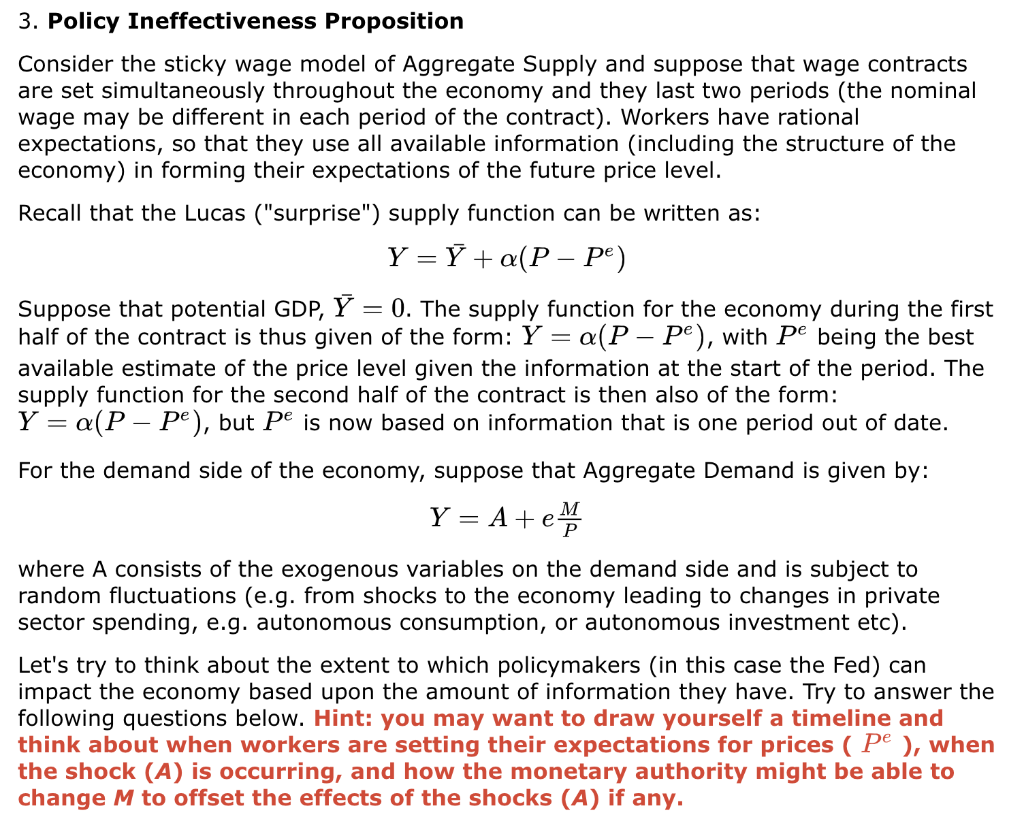

3. Policy Ineffectiveness Proposition Consider the sticky wage model of Aggregate Supply and suppose that wage contracts are set simultaneously throughout the economy and they last two periods (the nominal wage may be different in each period of the contract). Workers have rational expectations, so that they use all available information (including the structure of the economy) in forming their expectations of the future price level. Recall that the Lucas ("surprise") supply function can be written as: Y=Y+(PPe) Suppose that potential GDP, Y=0. The supply function for the economy during the first half of the contract is thus given of the form: Y=(PPe), with Pe being the best available estimate of the price level given the information at the start of the period. The supply function for the second half of the contract is then also of the form: Y=(PPe), but Pe is now based on information that is one period out of date. For the demand side of the economy, suppose that Aggregate Demand is given by: Y=A+ePM where A consists of the exogenous variables on the demand side and is subject to random fluctuations (e.g. from shocks to the economy leading to changes in private sector spending, e.g. autonomous consumption, or autonomous investment etc). Let's try to think about the extent to which policymakers (in this case the Fed) can impact the economy based upon the amount of information they have. Try to answer the following questions below. Hint: you may want to draw yourself a timeline and think about when workers are setting their expectations for prices (Pe), when the shock (A) is occurring, and how the monetary authority might be able to change M to offset the effects of the shocks (A) if any. a. During the first half of the contract, is there scope for stabilization policy (i.e. can the Fed do anything): i. if the authorities observe the current value of A ? ii. if the authorities observe A with a one-period delay? b. During the second half of the life of the contract, is there scope for stabilization policy: i. if the authorities observe the current value of A ? ii. if the authorities observe A with a one-period delay, and fluctuations in A are not generally correlated over time (that is the current value of A in any period is independent of the value in the previous period)? iii. if the authorities observe A with a one-period delay, and fluctuations in A are correlated over time (that is the current value of A in any period is related to its value in the previous period)? 3. Policy Ineffectiveness Proposition Consider the sticky wage model of Aggregate Supply and suppose that wage contracts are set simultaneously throughout the economy and they last two periods (the nominal wage may be different in each period of the contract). Workers have rational expectations, so that they use all available information (including the structure of the economy) in forming their expectations of the future price level. Recall that the Lucas ("surprise") supply function can be written as: Y=Y+(PPe) Suppose that potential GDP, Y=0. The supply function for the economy during the first half of the contract is thus given of the form: Y=(PPe), with Pe being the best available estimate of the price level given the information at the start of the period. The supply function for the second half of the contract is then also of the form: Y=(PPe), but Pe is now based on information that is one period out of date. For the demand side of the economy, suppose that Aggregate Demand is given by: Y=A+ePM where A consists of the exogenous variables on the demand side and is subject to random fluctuations (e.g. from shocks to the economy leading to changes in private sector spending, e.g. autonomous consumption, or autonomous investment etc). Let's try to think about the extent to which policymakers (in this case the Fed) can impact the economy based upon the amount of information they have. Try to answer the following questions below. Hint: you may want to draw yourself a timeline and think about when workers are setting their expectations for prices (Pe), when the shock (A) is occurring, and how the monetary authority might be able to change M to offset the effects of the shocks (A) if any. a. During the first half of the contract, is there scope for stabilization policy (i.e. can the Fed do anything): i. if the authorities observe the current value of A ? ii. if the authorities observe A with a one-period delay? b. During the second half of the life of the contract, is there scope for stabilization policy: i. if the authorities observe the current value of A ? ii. if the authorities observe A with a one-period delay, and fluctuations in A are not generally correlated over time (that is the current value of A in any period is independent of the value in the previous period)? iii. if the authorities observe A with a one-period delay, and fluctuations in A are correlated over time (that is the current value of A in any period is related to its value in the previous period)








